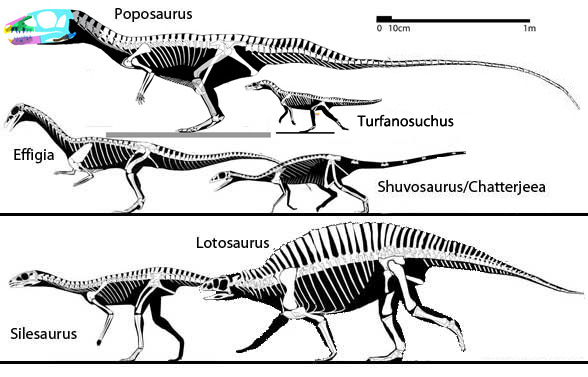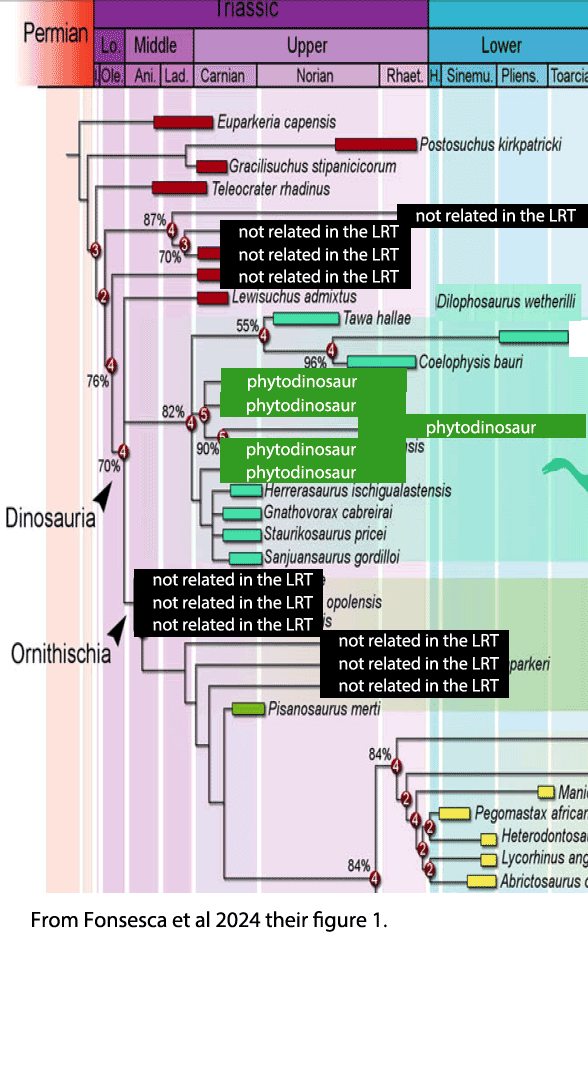Following on the heels of an earlier post
based on just an abstract, this post dives into the text of Fonsesca et al 2024. These updates also appear in that earlier post as a pre-script. The original post from a few days ago is also duplicated below. Thank you to Jason, for providing the PDF.
Fonsesca et al reported,
“While the origins and evolution of Ornithischia as an offshoot of Dinosauria are uncertain and controversial the later diversification of Ornithischia into morphologically distinct armoured, plated, crested and horned forms is well established.”
In the large reptile tree (LRT, 2321 taxa) the origins of Ornithischia were also established many years ago. I’ve been waiting for confirmation, refutation or modification with a similar taxon list and an independent characters list ever since.

Figure x. Poposaurs in the LRT to scale. Silesaurus nests here with similar taxa.
Fonsesca et al reported,
“new specimens have led to the recognition of a new dinosauromorph
clade: Silesauridae.”
The LRT nests Silesaurus in the Poposauria, along with Turfanosuchus, Poposaurus, Lotosaurus, Effigia and Shuvosaurus (Fig x) none of which are mentioned in the text. This is a traditional taxonomic omission and the Achilles heel of this paper.
To that point, Fonsesca et al reported,
“In the past decade, most authors agreed with the nesting of Silesauridae outside Dinosauria.”
‘Most authors’ can be wrong. Test this for yourself by adding taxa. Don’t follow the crowd. Do science. They might be correct, but you’ll never discover anything if you follow others.
Fonsesca et al reported,
“neither this model [the ‘Ornithoscelida model’] nor the ‘Phytodinosauria model’ has been widely adopted.”
This is how hypotheses get swept under the rug. It’s the job of workers to test previous hypotheses. Don’t wait until they become widely adopted. Be a bold scientist, not a timid child waiting for permission to test the current accepted hypotheses.
Fonsesca et al reported,
“One of the earliest-diverging ornithischian clades is Heterodontosauridae.”
Which begs the question, what was the other DI-verging clade? Clades always travel in pairs. According to their own figure 1 (Fig z here), which includes errors, Silesaurus and kin were much earlier with several diverging clades prior to Heterodontisauridae.
Same with the LRT (Fig x).

Figure z. Figure 1. from Fonsesca et al 2024, squeezed to fit this column. This is very much like the LRT with exceptions called out in frame 2.
Fonsesca et al reported,
“To address these issues, we adopt a ‘modified supermatrix’ approach, which involves the evaluation and incorporation of all characters and taxa into a single phylogenetic matrix,”
This usually doesn’t end up well (e.g. Hone and Benton’s failed attempt at finding the origin of pterosaurs.) Just add taxa to your own LRT and stop borrowing and trusting cladograms built by others. Otherwise all the faults and shortcomings of prior authors will be swept into your own study, which you hope, at its inception, will be pure and spotless.

Figure y. Subset of the LRT focusing on the Phytodinosauria with the addition of Mbiresaurus (not mentioned by Müller and Garcia 2023) in September 2022. Mbiresaurus is not mentioned in Fonseca et al 2024.
Fonsesca et al reported,
“As the major ornithischian radiations are all known to have diverged by the Late Jurassic, it would be expected that most ‘basal ornithischians’ would be from older deposits. However, the opposite is observed, with most species under this term being from the Cretaceous, including some from its final stage, the Maastrichtian.”
This is often, but not always true. In the LRT (Fig y) Daemonosaurus and Pisanosaurus (Fig 1) are both from the Late Triassic. So the authors’ collective instincts and logic were correct. Chilesaurus (Fig 1) was a Late Jurassic late survivor of the earliest ornithischian dichotomy (that included Late Triassic Daemonosaurus), but look what the authors said to dismiss it:
Fonsesca et al reported,
“The inclusion of Chilesaurus in an analysis with no tetanuran representation cannot be justified, and it is excluded here as a probable theropod whose phylogenetic position cannot be properly evaluated by this analysis.”
What happened to testing? Add taxa, even a few taxa in cases like this to find out for yourself which prior authors were correct while others were mistaken.
Late Triassic Mbiresaurus is the last common ancestor of Ornithischia + Sauropomorpha in the LRT (Fig y), so it should have been included in the Fonsesc et al taxon list.
Fonsesca et al reported,
“As the silesaurs are not considered early-diverging ornithischians a priori, they are treated as outgroup taxa in this analysis.”
This is called ‘cherry-picking’. Better practise is to Include so many taxa that your cladogram tells you which taxa are close to your area of focus, in this case the clade Ornithischia. The LRT recovers silesaurs so far outside the Ornithischia they should be reported then dismissed.
Worse yet, Fonsesca et al reported,
“The divergent anatomy of Pterosauria makes their inclusion and inclusion of characters that will resolve them difficult, as such only Dimorphodon macronyx, previously scored by Baron et al. (2017a, 2017b), was included from the clade.”
AaAAKKKKkkkk!!!! According to the LRT, the last common ancestor of pterosaurs and dinosaurs was the last common ancestor of all reptiles, Silvanerpeton, from the Early Carboniferous. Add taxa to your own LRT to find this out for yourself.
I just learned from Fonsesca et al about the
“the CoArTreeP (the Complete Archosauromorph Tree Project) by Ezcurra (2016) which contains up to 255 terminals and 890 characters in its latest iteration.”
We looked at the many problems of Ezcurra 2016 earlier here.
The “diphyletic model of Dinosauria” mentioned in the abstract.
Unfortunately the word ‘diphyletic’ is not mentioned elsewhere in the text.
I should have mentioned this earlier: phylogenetic miniaturization.
Like sauropodomorphs, Chilesaurus and Daemonosaurus are both rather large (Fig 1). Heterodontosaurus, Haya and Jeholosaurus are much smaller.
Also, it’s not the first appearance of traits, but a last common ancestor that determines clades. Keep that in mind when dealing with Ornithischia.
The rest of this blogpost is from the original posting based on the abstract alone.
>>>>>>>>>>>>>>>>>>>>>>>>>>>>>>>>>>>>>>>>>>>>>>>>>
From the Fonsesca et al 2024 abstract:
“Resolving the evolutionary relationships of early diverging (‘basal’) ornithischian dinosaurs is a challenging topic in palaeontology, with multiple competing hypotheses on the phylogenetic relationships of heterodontosaurids, ‘hypsilophodontids’, and other early-diverging forms. These hypotheses cannot be directly compared because they are derived from differently constructed datasets (i.e. distinct samples of taxa and characters).”
Solution: add taxa, both ingroup and outgroup.
“This study aims to address these issues by revising and combining the distinct datasets into a single analysis in order to create the most comprehensive dataset for the investigation of the phylogenetic relationships of early-diverging ornithischians.”
The LRT is more comprehensive.
“A diphyletic model of Dinosauria is supported, with silesaurs nesting as members of Ornithischia.”
Diphyletic? Not monophyletic? And no details in the abstract?
In the LRT silesaurs are outgroup poposaurs, not related to dinosaurs.
Add more poposaurs to find this out for yourself.
In the LRT Dinosauria remains monophyletic.
“Heterodontosauridae is resolved as a clade of non-genasaurian ornithischians, rejecting a potential relationship with Marginocephalia.”
No mention of Daemonosaurus and Chilesaurus (Fig 1)?
No mention of Sauropodomorpha?

Figure 1. Tested taxa in the LRT nesting in the Phytodinosauria from many years ago.
Given these taxon exclusions,
apparently there’s no reason to continue with this abstract. The authors’ analysis is not ‘comprehensive’.
References
Ezcurra MD 2016. The phylogenetic relationships of basal archosauromorphs, with an emphasis on the systematics of proterosuchian archosauriforms. PeerJ,
4(1), e1778. https://doi.org/10.7717/peerj.1778
Fonseca AO et al. (5 co-authors) 2024. A comprehensive phylogenetic analysis on early ornithischian evolution. Journal of Systematic Palaeontology 22(1):Article: 2346577.
https://doi.org/10.1080/14772019.2024.2346577
